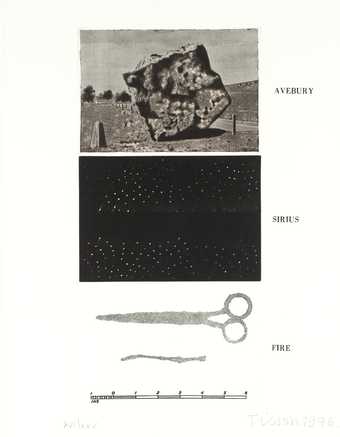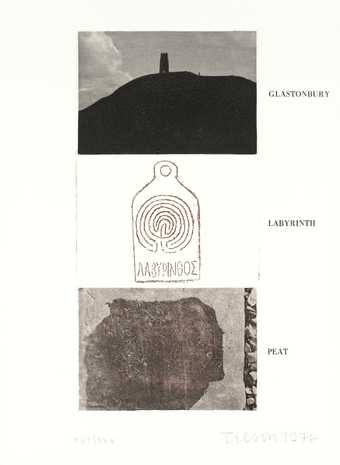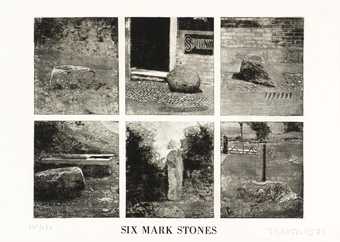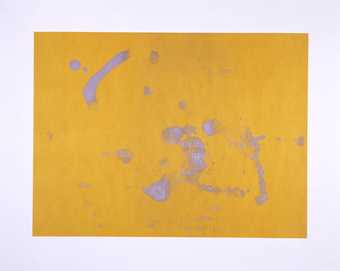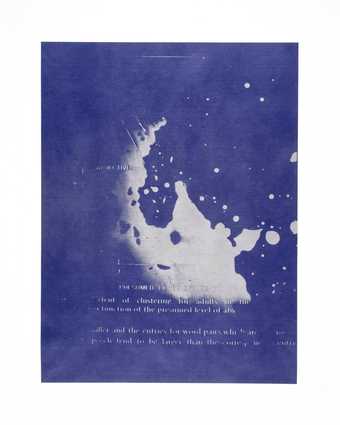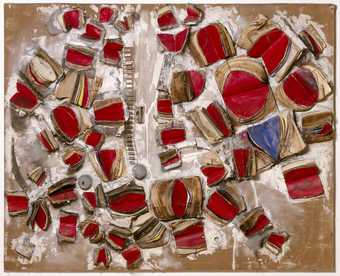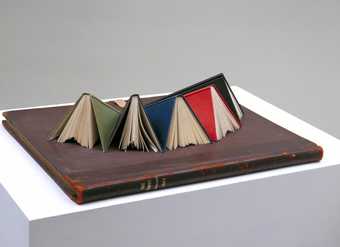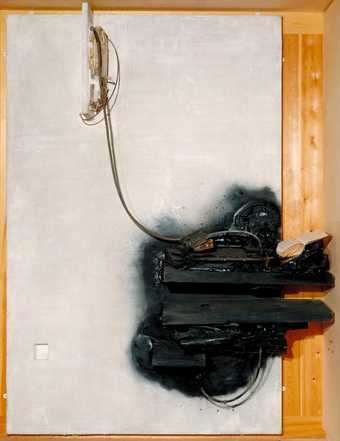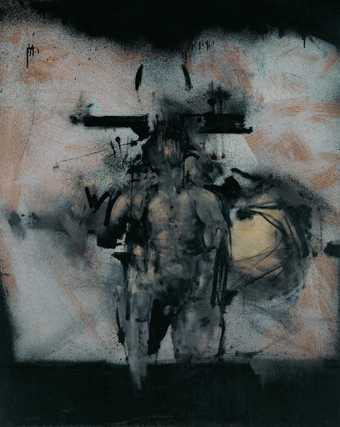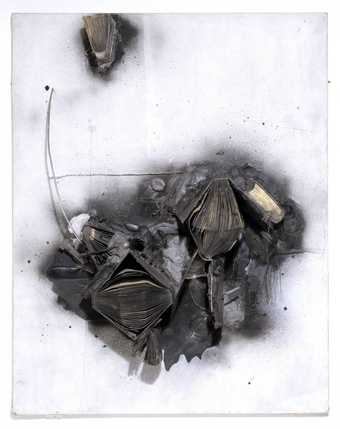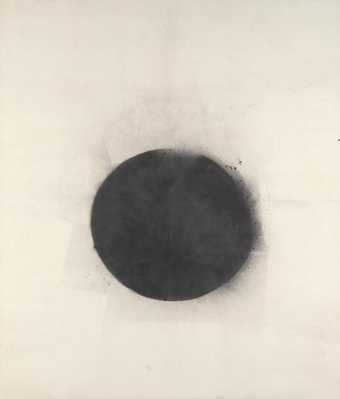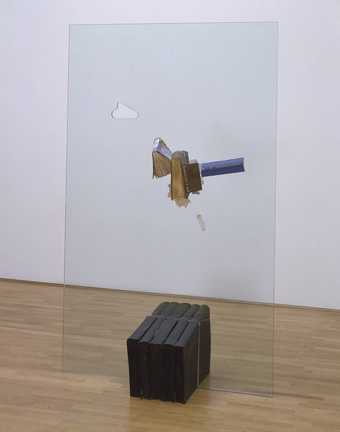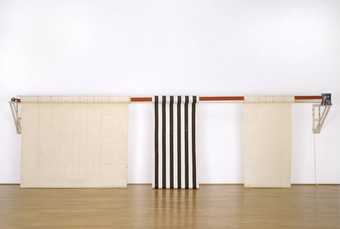- Artist
- John Latham 1921–2006
- Medium
- Wood, photographs, glass jar and shale
- Dimensions
- Object: 1219 × 1829 × 241 mm
- Collection
- Tate
- Acquisition
- Purchased 1976
- Reference
- T02071
Display caption
In 1966 Latham founded the Artist Placement Group with Barbara Steveni, Jeffrey Shaw and Barry Flanagan, to set up ‘placements’ for artists within organisations and businesses. The intention was that, by sharing skills, artists would play a more active and influential role in society.
In 1975-76 Latham undertook a placement with the Scottish Development Office. He was invited to come up with a plan for dealing with ‘bings’ or huge heaps of coal waste. Recognising that the bings had an ‘immaculate and classical nature’, Latham recommended they be preserved as monuments, thus eliminating the need for their costly removal.
Gallery label, February 2010
Does this text contain inaccurate information or language that you feel we should improve or change? We would like to hear from you.
Catalogue entry
T02071 DERELICT LAND ART: FIVE SISTERS 1976
Not inscribed
Blockboard panel painted white with shelf, photographs, glass jar, shale, 48 × 72 × 9 1/2 (121.9 × 182.9 × 24.1)
Purchased from the artist (Discretionary Fund) 1976
Exh: John Latham, Tate Gallery, June–July 1976 (32)
‘Five Sisters’ is a title caption in painted black capitals at the top right. Attached to the panel are sixteen photographs which show views of a ‘Bing’ or shale heap, one of several which the artist studied in the Midlothian and West Lothian regions while on a ‘placement’ with the Scottish Development Department. The photographs are of various sizes and were laid out on the panel by the artist Rita Donagh who was also responsible for photographing all the views except one. Two separate groups of her photographs consist of prints placed edge to edge to make composite or montage views. The rest are placed separately. The single photograph not taken by Rita Donagh for the artist is an official aerial view produced by the Scottish Office. It carries the typed caption ‘THE FIVE SISTERS IN 1960 SHOWING ALSO THE ADDIEWELL SITE (LEFT) BEFORE DEMOLITION BEGAN’.
As a member of APG - the Artist's Placement Group, an organisation of which Latham had been a principal founder ten years earlier whose function is to place artists in administrative organisations - Latham became officially attached, from December 1975 to April 1976, to a government agency, the Scottish Development Department. In his capacity as a paid temporary civil servant the artist was invited to consider the problem of derelict land (along with other problems, such as urban renewal.) He wrote a report recommending the preservation of five of the Bing sites as monuments, each of which possessed its own highly interesting form, as an alternative to their extremely costly and almost impossible removal. He examined the Bings minutely, became familiar with their separate and highly individual characteristics and devised ways of reversing the normal attitudes to such mountains of waste from rejection shame or forced tolerance to positive acceptance. Such a reversal is highly typical of his conceptualist art work over many years where through gestures and events of widely different types, Latham had demonstrated his belief in the value of reversing conventional attitudes, processes and even words. In the case of the Bings, he saw the immediate advantage of his proposals as being the saving of a large amount of public money which would no longer be needed for their clearance. It was also typical of Latham's working method as an artist and fully in the spirit of APG that he should invite a fellow artist to collaborate in the project by taking photographs and finally by arranging the photographs, in the case of T02071 on a panel. In his Feasibility Study prepared for the Development Department, one of his main proposals was that the Agency should employ a number of artists who would deal creatively with derelict sites.
Published in:
The Tate Gallery 1976-8: Illustrated Catalogue of Acquisitions, London 1979
Explore
- architecture(30,960)
-
- industrial(2,075)
-
- waste tip(19)
- formal qualities(12,454)
-
- classification(114)
- photographic(4,673)
- transformation(186)
- furnishings(3,081)
-
- shelf(46)
- jar(113)
- Lothian, West(70)
- Scotland(2,977)
- social comment(6,584)
-
- ecology(61)
- inscriptions(6,664)
-
- caption(358)
You might like
-
Joe Tilson [no title]
1976–7 -
Joe Tilson [no title]
1976–7 -
Joe Tilson [no title]
1976–7 -
John Latham Ben N
2004 -
John Latham Presumed Level of Abstraction
2004 -
John Latham Film Star
1960 -
John Latham Burial of Count Orgaz
1958 -
John Latham One-Second Drawing (17” 2002) (Time Signature 5:1)
1972 -
John Latham Five Sisters Bing
1976 -
John Latham Observer IV
1960 -
John Latham Man Caught Up with a Yellow Object
1954 -
John Latham Belief System
1959 -
John Latham Full Stop
1961 -
John Latham God is Great (no. 2)
1991 -
John Latham Time-Base Roller
1972


